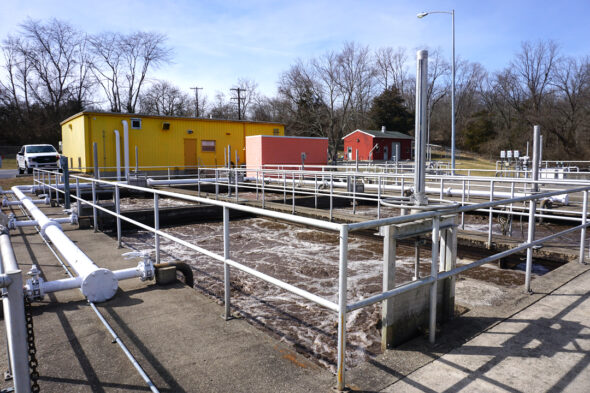
According to tests conducted by the Ohio Department of Health, a significant amount COVID-19 viral shedding was detected at the Village's municipal water treatment plant. (Photo by Reilly Dixon)
Samples show COVID in Yellow Springs wastewater
- Published: May 2, 2022
While the Centers for Disease Control and Prevention, or CDC, continues to list Greene County as having a “low” community level for the coronavirus based on a revised metric adopted earlier in the year, recent local wastewater samples show an increase in COVID-19 viral shedding in the village over the past couple of weeks.
According to the Ohio coronavirus wastewater monitoring network website, the wastewater samples are examined for gene copies or fragments of the virus that cause COVID-19. That data is collected in a way that pinpoints an increase within a community’s watershed boundary.
An email dated Tuesday, April 12 from representatives of the Ohio Department of Health, or ODH, to Village Manager Josué Salmerón, reported that the viral shed in Yellow Springs’ wastewater “increased tenfold” in the first week of April.
The ODH website says that increases and decreases are determined based on average samples.
The website reads, in part:
“An arrow symbol is listed next to the facility name that describes if the flow adjusted gene copies (shown in million gene copies per day) are increasing, decreasing or steady. This is done by comparing the average of the last two samples with the average of the prior third and fourth sample in order to determine the percentage of change between the averages.”
According to the email to Salmerón, the flagged samples were taken between March 28 and April 6. Using the ODH reporting model, Yellow Springs has had an 121% increase. Springfield has also experienced a significant increase of 135% as of April 6. More recent data has not been released by the state.
In the Village Manager’s report to Village Council on April 18, Salmerón noted that while wastewater monitoring may alert municipalities to spikes in COVID-19 cases, it may not reflect decreases rapidly. The ODH website explains this further, saying that the slow decline is the result of viral shedding that takes place for some time after a person has recovered and is no longer considered contagious.
According to the email to Salmerón from the ODH, “Because wastewater data can be a good leading indicator of potential risk of community spread, it presents an opportunity to proactively direct testing and tracing resources to prevent outbreaks before cases increase.”
The Yellow Springs News encourages respectful discussion of this article.
You must login to post a comment.
Don't have a login? Register for a free YSNews.com account.















No comments yet for this article.